I didn’t need a pandemic or a war to teach me that smart cities weren’t the future — but it sure drove the message home.
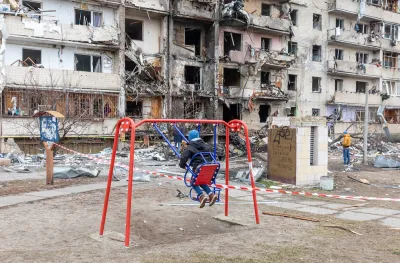
This essay is the third in a series of pieces by urban designer Mikael Colville-Andersen called Urbanism in a Time of War, reported from Kyiv. Read the other pieces in this series here.
I think it’s safe to say that for the past few years, things haven’t been going quite as well as we might have hoped. A global pandemic, a brutal land invasion of Ukraine that threatens the security of Europe, a geopolitical doomscape fueled by the White House — and looming above it all, the darkening clouds of climate change.
But hey, I’m Danish, and we have an expression for this: “nothing is so bad that it isn't good for something.”
Starting in the early days of the pandemic, I began documenting how cities and urban citizens were reacting to the crisis. While the scientific community went above and beyond — developing vaccines in record time — what happened in our cities was decidedly low-tech.
Think about it. Many people worked from home, which sparked a cascade of effects. We proved to skeptical employers that productivity could thrive when people had a say in their work-life balance. We walked through our neighborhoods more than ever, reconnecting with our local environments, gaining a stronger sense of ownership. I discovered previously unseen parks, sculptures, and cool spaces tucked into the corners of my Copenhagen neighborhood. I noticed architectural details on buildings I’ve passed for two decades.
I started seeing the potential for urban infill and documented which streets had more trees than others. I would never have had time to do such things without the lockdowns. Add to that the unexpected joy of streets devoid of car noise and the amplified birdsong soundtrack.
Slow-moving, bureaucracy-laden cities suddenly showed they could pivot fast, (who knew?!) injecting creativity into public space solutions. Temporary bike lanes and widened sidewalks popped up globally — not just for social distancing but to offer alternatives to nervous transit riders. The cool cities like Paris and Milan saw this as an important opportunity. In those cities, most of the new infrastructure is now permanent.
Many other cities backpedaled, removing their “temporary” interventions. But one legacy remains across much of the world: outdoor seating. Taking away a few parking spots to give bars and restaurants room for tables and chairs proved wildly successful. And yeah — people will sit outside in cold weather. Told you so.
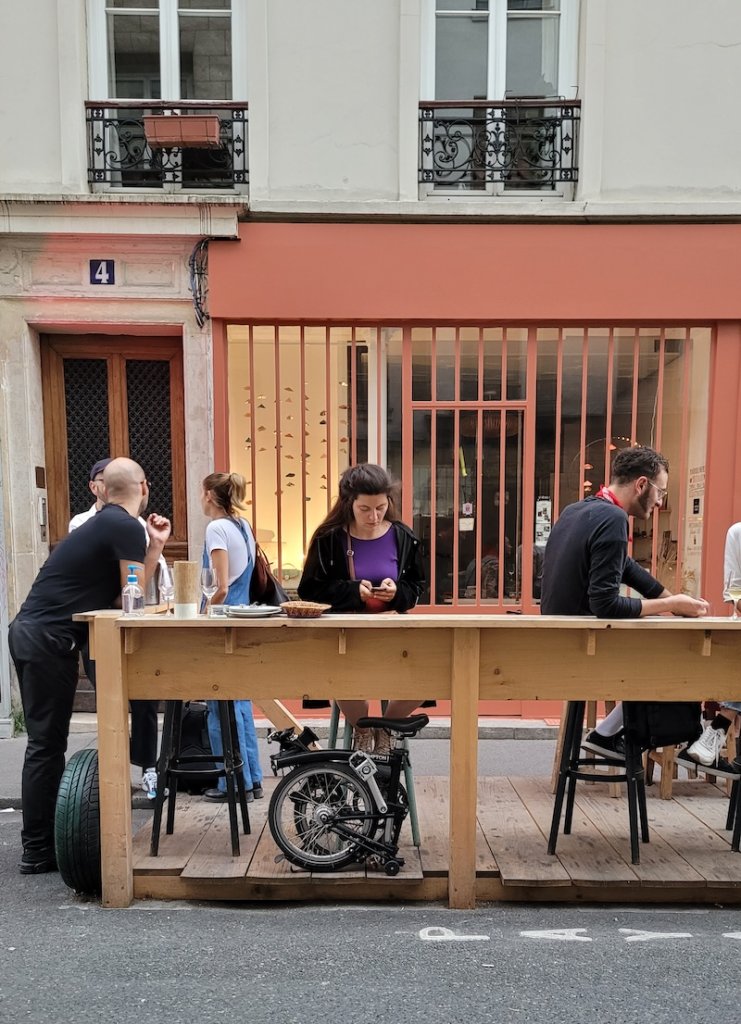
Kudos to the legends of that Covid age, like the mayor of Vilnius, who turned a main square into “the world’s largest café.” Yes, he wanted businesses to survive—but he also knew something else: that urban citizens have a deep desire to remain part of the urban theater.
When everything else feels chaotic and our lives are upended, simply sitting at a table or on a bench in the city becomes a Maslovian need. The brick, mortar, and trees become a quiet testament that we still stand. That we’re still here. The scenography of urban life becomes a pillar of calm amidst the chaos.
And none of this came from "smart cities." It came from smart people making cities livable when everything else was falling apart. And the best part? The solutions that worked were beautifully analog. Paint. Benches. Straw bales. Zip ties and plywood. No Silicon Valley tech bro required.
We went back to the future, pulling basic urban concepts from the seven thousand years of human city-making before car-centric planning derailed it all.
Fast forward a bit. On February 24, 2022, the world watched in shock as Russia launched a massive, illegal, and brutal invasion of a European country. I came to Ukraine in June 2022, and ever since, I’ve been in awe of the myriad ways urban Ukrainians have responded to the hardship — and amazed at the simplicity of it all.
We think we know how we’ll handle extreme adversity because we’ve seen enough dystopian fiction. But peel away the Hollywood gloss of those films and series, and you find some urban details that ring true: off-grid living, prepping, bikes as vital tools.
Yeah. Ukraine saw all that, shrugged and raised the ante. It’s hard to sum up all I’ve seen and been part of. It’s constant. My daily life in Kyiv and other cities is filled with it.
First — always, in my career — bicycles. Years ago, I wrote about how bicycles are essential in times of crisis. Little did I know then that I would one day see it daily. The used, donated bicycles I bring from Europe have become lifelines. One unwanted bike becomes a vehicle of liberation. Social workers use them to deliver food, water, humanitarian aid, and medicine to vulnerable citizens in devastated areas. I see bikes everywhere, doing what they were designed to do for over 130 years: transporting people and goods.
In Mykolaiv, where the water supply was destroyed in the early days of the invasion, the city converted trams and trolleybuses into mobile water stations. No apps. No tech start-ups. Just practical, honest responses. It was a masterclass in dual-purpose infrastructure. A theme that now occupies my mind constantly.
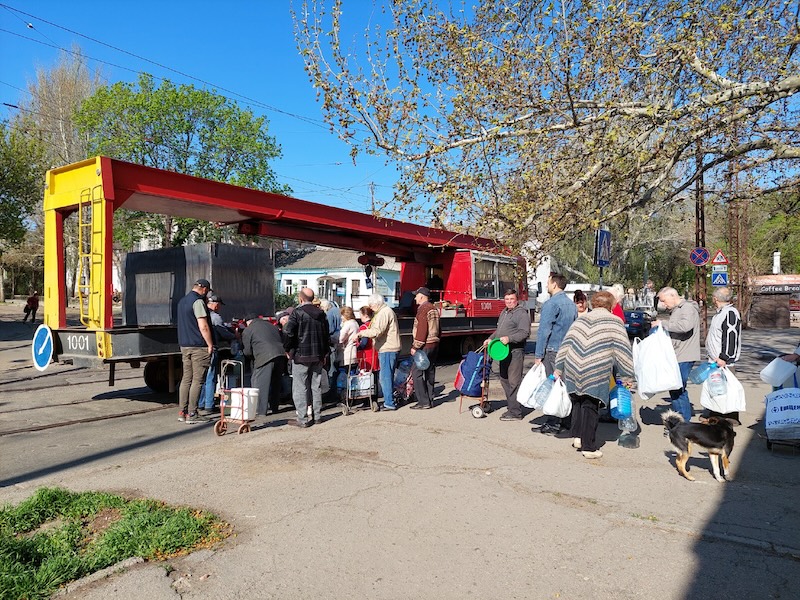
When designing the Cycling Strategy for Mykolaiv, a Ukrainian colleague said to me, “dude, remember evacuation routes…”. Of course. Of course. During the early days of the invasion, so many Ukrainians grabbed a bike and used it to flee the invading forces. I had never planned a cycling network for both daily commutes and wartime evacuation. But now I will think about it every time.
In Japan, they are way ahead of the curve regarding dual-design. Faced with earthquakes and tsunamis, they use dual-design in neighbourhood parks, combining landscape architecture with disaster preparedness.
In the first winter of the invasion, Russia targeted Ukraine’s energy infrastructure. The goal? Freezing Ukrainians into submission. The response? Generators. Everywhere. Small cafés had one outside for the coffee machine. Hotels ran entire buildings on them. My office has one that lights up the space with a single pull. Sure, burning diesel is no longer cool — but here, that low hum of simple machinery is the sound of resilience.
In a crisis, there’s always opportunity for positive urban change. In Kyiv, where I volunteer daily, I live in Podil — a proud, independent and historic neighborhood. Beautiful architecture, third-wave coffee, and a clear civic spirit.
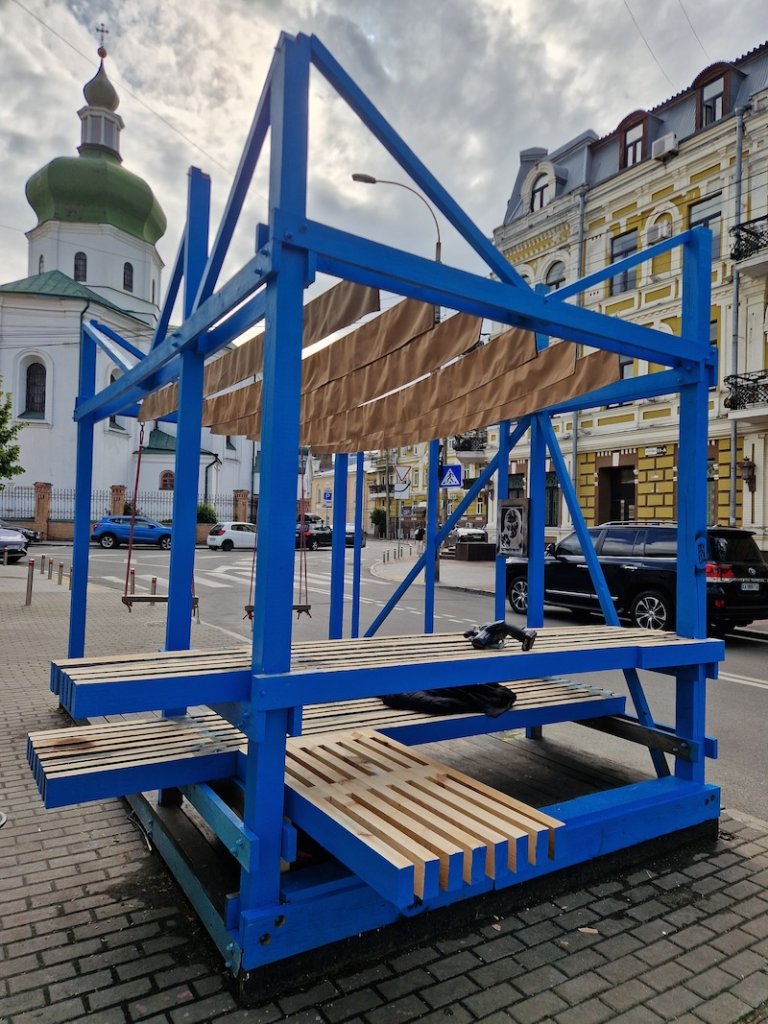
It began with a sad, rundown parklet — one of the city’s first. Installed years ago by local architects, it had fallen into disrepair. I spent €50 on paint, grabbed some friends and beers, and brought it back to life. We fixed the swings, too.
The next day? Kids swinging, teens hanging, elderly women chatting. Later, we repaired some neglected outdoor ping-pong tables. Low effort. Low cost. Immediate impact. Some basketball guys wandered over. “Can we help?”
Yes. Always yes. That’s how you activate public space. Not with a white paper or predictive analytics — but with presence, trust, and a paintbrush or drill. We need more of that. On every street, in every city.
The beauty of analog solutions is their adaptability. The pandemic and the war in Ukraine have made it crystal clear: the same basic ideas apply to the greatest challenge we face — climate change. And no, it won’t be fancy. It will be basic and pragmatic.
I don’t know about your Instagram feed, but the algorithms know what I like to see. My feed is filled with ideas and solutions for mitigating climate change. All of them are beautifully simple, practical and ready to implement. I hail from Copenhagen, the only city in the world with the city-wide climate adaptation plan and more than a decade of work already done creating a "sponge city" to tackle the new normal: massive cloudbursts. Permeable surfaces, reservoirs and pumps. Low-tech goodness.
Streets should move people in peace — and evacuate them in war. Public spaces should welcome life in spring — and store water during thousand-year storms. Infrastructure should be beautiful on a good day — and essential on the worst.
I’m in the process of what is one of my craziest projects — the world’s largest temporary urbanism venture on the historic Kontraktova Square called TORV Kyiv. Transforming 11,000 m3 of lifeless asphalt into a space with seating, trees, plants, shade and physical activity. Why? Urbanism, when done right, is always good for mental health. We’ll also show how we can reduce the heat island effect, improve biodiversity and give ownership of the space back to the citizens. All of it built and implemented with a tireless army of volunteers.

We’re constantly told that smart cities are the future. That the next wave of urban life will be managed by sensors, optimized by AI, and made frictionless by platforms. Homo sapiens are inherently “techno-optimists” and that questionable character trait has led us down so many wrong paths. After five years of living through back-to-back crises — a pandemic, and then war in Europe — I’m convinced of something simpler, and far more powerful:
When the grid goes down, when systems fail, when supply chains break, the only things that keep working are the ones that don’t rely on someone else’s server. A bike to move stuff. A barrel for rainwater collection. A permeable surface replacing asphalt. A community garden for food security. Citizens planting trees. Empty cans and plastic bottles transformed into solar collectors to heat up hot water. Interpersonal relationships strengthened by the urban fabric and not separated by flawed urban planning. Here in Ukraine, I’ve seen this truth play out again and again.
Futureproofing means remembering
As climate change intensifies and wars and economic shocks continue to show up — as they will — the cities that thrive will not be the ones with the most tech. They will be the ones with the most practice. The most nimble reflexes and collective memory, as well as the most courage to do simple things well. Let’s not wait for the next disaster to remember how powerful that can be.
Now we talk about “activating” public space, “reclaiming” streets, “greening” infrastructure like these are radical concepts. They’re not. They’re ancient. We’re just getting back to where we were before we lost the plot.
And when disaster hits, it won’t be the “smart city” (whatever that actually is) that shines. It’ll be the analog darlings. The ones with benches that double as barbeques, trams that deliver water, and fleets of bikes doing logistics. All led by people who know how to pivot—and don’t wait for permission.
Let’s start building that analog, human-centered toolbox. No need to invent everything. Just remember.
Remember how to adapt.
To include.
To listen.
To share.
To act.

Planetizen Federal Action Tracker
A weekly monitor of how Trump’s orders and actions are impacting planners and planning in America.
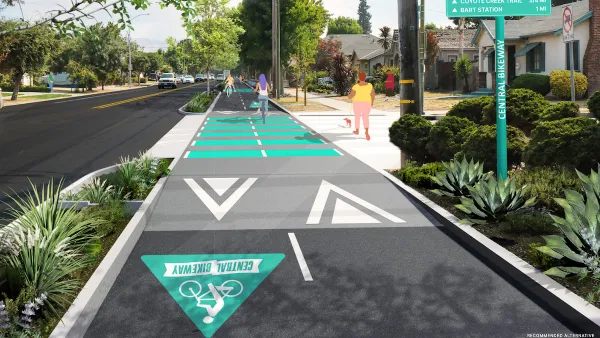
Silicon Valley ‘Bike Superhighway’ Awarded $14M State Grant
A Caltrans grant brings the 10-mile Central Bikeway project connecting Santa Clara and East San Jose closer to fruition.

Amtrak Cutting Jobs, Funding to High-Speed Rail
The agency plans to cut 10 percent of its workforce and has confirmed it will not fund new high-speed rail projects.

Planting for Change: How Trees Are Powering Climate Action
"Combating Climate Change with Trees" highlights how Southern California communities are strategically planting and nurturing urban forests to cool neighborhoods, improve air quality, and advance environmental justice.

Could Planners Adopt a 'Place Sherpa' Role?
Building upon the framework of a local housing panel, Chuck Wolfe suggests that advocacy and policy discussions would be enhanced by a “sherpa mindset” that focuses on lived experiences, facilitates applied knowledge of urban places, and promotes stakeholder discussion.

California Advances Its 30x30 Conservation Goals
California is making significant progress toward its 30x30 conservation goals, but looming federal rollbacks and gaps in biodiversity protections could threaten the state’s efforts to protect lands and coastal waters by 2030.
Urban Design for Planners 1: Software Tools
This six-course series explores essential urban design concepts using open source software and equips planners with the tools they need to participate fully in the urban design process.
Planning for Universal Design
Learn the tools for implementing Universal Design in planning regulations.
Caltrans
City of Fort Worth
Mpact (founded as Rail~Volution)
City of Camden Redevelopment Agency
City of Astoria
City of Portland
City of Laramie




























